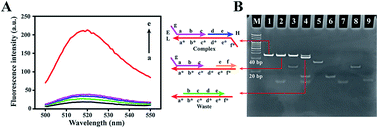A homogeneous fluorescent biosensing strategy for highly sensitive detection of DNA based on a programmed entropy-driven strand displacement reaction and DNAzyme for dual recycling amplification†
Abstract
In this study, an enzyme-free and homogeneous fluorescent biosensing strategy is described for the detection of DNA based on an entropy-driven strand displacement reaction (ESDR) and DNAzyme. In the presence of target DNA, toehold-mediated strand displacement results in the circulation of target DNA and release of DNAzyme sequences from the three-stranded complex. Upon cyclic amplification, one target catalyzes the formation of Mg2+-dependent DNAzymes. The activated DNAzymes can catalyze the cyclic cleavage of fluorophore/quencher labeled DNA substrates, resulting in significantly amplified fluorescent signals. The P53 gene, one of the most intensively investigated genes due to its dysregulation in the majority of human cancers, was used as the model target DNA. Under the optimal experimental conditions, the fluorescent signal had a linear relationship with the logarithm of the DNA concentration in a wide range from 500 fM to 10 nM, and the detection limit was estimated to be 220 fM. In addition, the assay also possessed excellent detection specificity and could be applied to the analysis of DNA spiked plasma samples. Therefore, this strategy presents a new method for sensitive DNA assay and might become a potential alternative tool for biomolecule detection.

- This article is part of the themed collection: Analytical Methods Recent HOT articles


 Please wait while we load your content...
Please wait while we load your content...